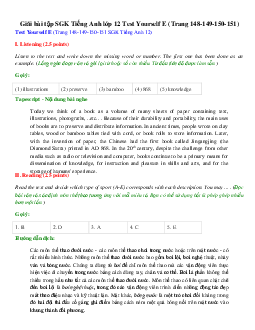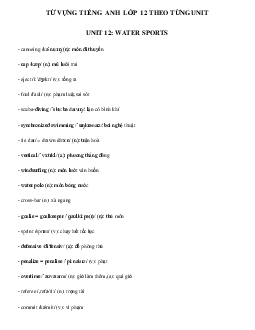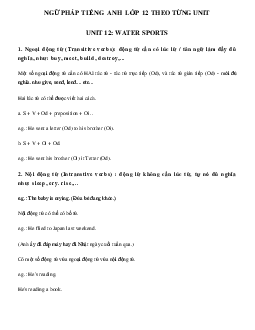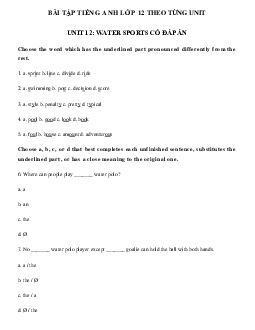








Preview text:
Giải bài tập SGK tiếng Anh lớp 12 Unit 12 WATER SPORTS
A. Reading (Trang 128-129-130 SGK Tiếng Anh 12)
Before you read (Trước khi bạn đọc)
Work in pairs. Look at the picture and answer the questions. (Làm việc theo cặp. Nhìn vào tranh và trả
lời các câu hỏi.) Water Polo - Bóng nước
1. Can you name the sport in the picture? (Bạn có thể gọi tên môn thể thao trong tranh là gì không?) => It's water polo.
2. Where is it played? (Nó được chơi ở đâu?) => It's played in a pool.
3. How do people play it? (Người ta chơi môn thể thao này như thế nào?)
=> People play it with a ball, which is passed to each other by hand or advanced with the head over the
water between the player's arms.
While you read (Trong khi bạn đọc)
Read the passage and do the tasks that follow. (Đọc đoạn văn và làm bài tập kèm theo.) Hướng dẫn dịch:
Môn bóng nước được chơi trong một cái hồ sâu 1,8 mét, dài 30 mét và rộng 20 mét, với
khung thành cao 3 mét và cao hơn mặt nước ít nhất 0,9 mét. Khung thành được đánh dấu
bằng các cột dọc, một xà ngang và một tấm lưới.
Mỗi đội có 7 cầu thủ, 6 tay bơi và 1 thủ môn. Đội chủ nhà đội mũ trắng, đội khách đội mũ
xanh và thủ môn đội mũ đỏ với số 1 màu trắng.
Giống như bóng đá, trò chơi bắt đầu với quả bóng ở giữa hồ và cả hai đội lao ra tranh
bóng từ vạch gôn của họ. Quả bóng được đưa tới trước bằng cách chuyền một tay hoặc
bơi với đầu nổi trên mặt nước và bóng ở giữa hai cánh tay vì thế bóng lướt đi trên gợn
sóng do đầu của cầu thủ tạo ra. Ngoại trừ thủ môn, không cầu thủ nào được quyền giữ bóng bằng hai tay.
Các cầu thủ hậu vệ không được phép ngăn cản đối phương di chuyển trừ khi cầu thủ kia
đang giữ bóng. Những lỗi nghiêm trọng sẽ bị một quả phạt trong vòng một phút trong
vòng cấm địa và cầu thủ nào phạm 5 lỗi sẽ bị truất quyền thi đấu.
Đối với những lỗi nhỏ, chẳng hạn như giữ hoặc đấm bóng sẽ được hưởng một cú ném
bóng tại điểm phạm lỗi. Phải có ít nhất hai cầu thủ chạm bóng sau cú ném đó thì bàn thắng mới được tính.
Trận đấu được chia làm 4 hiệp, mỗi hiệp từ 5 tới 8 phút. Sau tỉ số hòa, có hai hiệp phụ,
mỗi hiệp kéo dài 3 phút. Nếu trận đấu vẫn hòa sau hai hiệp phụ, hai đội sẽ tiếp tục chơi
thêm 3 phút nữa cho đến khi có quyết định của trọng tài.
Task 1. Work in pairs. Match the words in column A with their meanings in column B. (Làm việc theo
cặp. Ghép các từ ở cột A với ý nghĩa của chúng ở cột B.) Gợi ý: 1. e 2. c 3. a 4. b 5. d Từ vựng:
1. opponent: đối thủ2. penalize: phạt3. eject: đuổi4. foul: lỗi5. tie: tỉ số hòa
Task 2. Complete the following sentences, using the information from the passage. (Hoàn thành câu
sau, sử dụng thông tin từ đoạn văn.) Gợi ý:
1. 1,8; 30 metres; 20 metrers
2. while caps; blue caps; red caps with the number 1 in white
3. their own goal lines
4. holding or punching the ball
5. five to eight minutes
Task 3. Work in pairs. Ask and answer the following questions. (Làm việc theo cặp. Hỏi và trả lời
những câu hỏi sau.)
1. Where can people play water polo?
=> People can play it in a pool.
2. Where is the ball when the game starts?
=> It is in the centre of the pool.
3. How can the ball be advanced?
=> The ball can be advanced by passing with in a hand or swimming with the head above the water and
the ball between the arms so it rides on the waves created by the swimmer's head.
4. Which players are allowed to hold the ball with both hands?
=> Only the goalies can hold / is allowed to hold the ball with both hands.
5. What happens to a player who commits five personal fouls?
=> The player is ejected after committing five personal fouls.
After you read (Sau khi bạn đọc)
Work in groups. Make a comparison between football and water polo, using the following
suggestions. (Làm việc nhóm. So sánh giữa bóng đá và bóng nước, sử dụng các gợi ý sau.) Gợi ý: Football Water polo places to the sports on a pitch or a in a pool play playground number of 11 7 players
- the ball is advanced with a - minor foul, such as holding or fool.
punching the ball, is awarded with a
free throw from the spot of the foul.
- only the goalie can hold the ball in hands.
- major foul is penalized by one main rules minute in the penally box.
- a touch of the ball on the arm
or hand is awarded with a shot - a player committing five personal from the spot of the foul. fouls is ejected.
- major foul in the penalty area is awarded a penaily from a penally spot. - a player is ejected when be received a red card. length of two halves, 45 minutes each
into quarters from 5 to 8 minutes in game length
B. Speaking (Trang 131-132 SGK Tiếng Anh 12)
Task 1. Work in pairs. Look at the pictures and match the names with the appropriate water sports.
(Làm việc theo cặp. Nhìn vào hình và ghép tên với môn thể thao dưới nước thích hợp.) Gợi ý:
Tên các môn thể thao theo thứ tự từ trái qua phải như trong sách giáo khoa Tiếng Anh 12: swimming: bơi lội water polo: bóng nước synchronized swimming: bơi nghệ thuật windsurfing: môn lướt
scuba-diving: môn lặn với rowing: môn đua thuyền ván buồm bình khí
Task 2. Work in pairs. Look at the table and talk about each of the water sports. (Làm việc theo cặp.
Nhìn vào bảng và nói về mỗi môn thể thao dưới nước.) Example:
Water polo is played in a pool. It is played with a ball and people play it in a team. Gợi ý:
- Rowing is usually played in a lake or on a river. It's played in a boat and people in a learn use oars to push the boat to go forwards.
- Wind-surfing is played in the sea or a lake, especially where there is strong wind. It is played with a
board and a sail. People can play it individually.
- Scuba-diving is played in the sea. People who play it must have required equipment an air tank, a
regulator, a pair of fins and a mask. People usually play it in pairs. This sport is rather dangerous when
you dive in a deep sea because you can be attacked by sharks.
Task 3. Work in groups. Discuss the question: Which of the above sports would you prefer to play/to
participate in? Explain why? (Làm việc nhóm. Thảo luận câu hỏi: Môn thể thao nước nào trong những
môn kể trên bạn thích chơi/tham gia hơn? Giải thích tại sao?) Example:
I prefer scuba-diving to water polo because it is adventurous. However, it can be
dangerous because you can easily be attacked by sharks. Gợi ý:
- I like windsurfing more than water polo because it is adventurous. However, it can be dangerous
because you can easily be drowned.
- I prefer water polo to rowing because it's fun and it's not dangerous.
- I prefer swimming to rowing because it's an easy, interesting and healthy sport. Swimming not only
gives you good health, but it can also give you a good shape. When you swim, all parts of your body
move. And it's this move that stimulates all the muscles of your body.
C. Listening (Trang 132-133-134 SGK Tiếng Anh 12)
Before you listen (Trước khi bạn nghe)
- Look at the picture and discuss in groups whether this water sport is played. (Nhìn vào tranh và thảo
luận theo nhóm xem môn thể thao dưới nước này được chơi:)
- in a swimming pool or in the sea (trong hồ hay trên biển)
- with or without equipment (có hay không có dụng cụ)
- individually or in a team (cá nhân hay đồng đội)
Gợi ý thảo luận:
A: Do you know synchronized swimming?
B: Yes, I do. This sport is only played in a swimming pool. It's a complicated sport because it requires
the players to practise a lot beside being a good swimmer.
C: And this sport is played with music and die swimmer must wear a nose clip.
A: And it can be played either individually or in a team. - Listen and repeat.
- Synchronized swimming: môn bơi nghệ thuật
- Annette Lellerman (tên người)
- Katherine Curtis (tên người)
- Chicago Teacher's College: Trường Sư phạm Chicago
- Wright Junior College: Trường Cao đẳng cộng động Wright
- Amateur Athletic Union: Hiệp hội thể thao không chuyên
While you listen (Trong khi bạn nghe)
Task 1. Listen to a woman talking about synchronized swimming and circle ... . (Nghe một phụ nữ nói
về môn bơi nghệ thuật và khoanh tròn đáp án (A, B hoặc C) đúng nhất để hoàn thành mỗi câu sau.) Gợi ý: 1. B 2. C 3. A 4. B 5. A
Task 2. Listen again and answer the questions. (Nghe lại và trả lời câu hỏi.)
1. Who invented synchronized swimming? (Ai đã phát minh ra môn bơi nghệ thuật?)
=> The great Australian swimmer, Annette Leilerman did.
2. When did Katherine Curtis found a water ballet club? (Khi nào Katherine Curtis thành lập câu lạc bộ
múa ba-lê dưới nước?)
=> She founded a water ballet club in 1923.
3. Who developed the competition rules of synchronized swimming? (Ai đã phát triển các luật thi đấu
của môn bơi nghệ thuật?) => Curtis did.
4. When were the first formal national championships conducted? (Khi nào thì kì vô địch quốc gia đầu
tiên được tổ chức?)
=> They were conducted in 1946.
5. When did synchronized swimming become an Olympic event? (Khi nào thì môn bơi nghệ thuật trở
thành môn thi Olympic?)
=> It became an Olympic event at the Los Angeles Games in 1984.
After you listen (Sau khi bạn nghe)
Work in groups. Talk about the history of synchronized swimming, using the cues below.(Làm việc
nhóm. Nói về lịch sử của môn bơi nghệ thuật, sử dụng các gợi ý dưới đây.) Gợi ý:
A: When did the synchronized swimming come into existence? B: In 1907.
C: Who developed this sport and introduced it to school curriculum?
D: Katherine Curtis. And 1923, she founded a water ballet club in Chicago.
A: When did it become a publicly competition? B: In 1939 in Chicago.
C: When was the synchronized swimming accepted as a competitive sport?
D: In 1941 by the AAU, which was founded in 1940.
A: And in 1946, this sport was formally played for the first time in the national championships conducted by the AAU.
B: And in 1984 synchronized swimming became an Olympic event al the Los Angeles Games.
Tapescript - Nội dung bài nghe
D. Writing (Trang 134-135 SGK Tiếng Anh 12)
Task 1. Below are the instructions for warm-up exercises before swimming. Read and match each
sentences ... . (Dưới đây là hướng dẫn cho bài tập khởi động trước khi bơi. Đọc và ghép mỗi câu với một
động tác chính xác. Hành động đầu tiên đã làm ví dụ cho bạn.)
1. Hạ tay xuống, đưa tay về ngang hông.
2. Đứng dạng chân, đưa tay thẳng về phía trước, chụm đầu ngón tay.
3. Hạ cánh tay xếp theo hông trở về vị trí ban đầu.
4. Đưa tay cao qua đầu, nhìn thẳng về phía trước. Gợi ý: a) - 2 b) - 4 c) - 1 d) - 3
Task 2. Look at the pictures below. Write the instructions for one warm-up exercise before playing
water polo. Use the verbs in the box. (Nhìn vào hình dưới đây. Viết hướng dẫn cho bài tập khởi động
trước khi chơi bóng nước. Dùng động từ trong khung.) Gợi ý:
1. Set yourself in vertical position.
2. Stand with your feet apart, raise your hands above your head.
3. Bend forwards, fingertips touch the ground.
4. Bend again, fingertips touch the ground between the feet.
5. Finally put cach arm back to the first position.
E. Language Focus (Trang 135-136-137 SGK Tiếng Anh 12) Grammar
Exercise 1. Which of the following verbs can have an object, and which not? (Động từ nào trong số
động từ sau có thể có một tân ngữ (túc từ), và động từ nào không?)
- Các động từ có thể có tân ngữ hay còn gọi là ngoại động từ (Transitive Verb), chúng là:
sleep (có đủ giường cho một số người)
read, write, meet, help grow (trồng)
climb (leo lên)
rain (đổ, trút)
- Các động từ không thể có tân ngữ hay còn gọi là nội động từ (Intransitive Verb), chúng là: sleep (ngủ)
arrive, lie, exist, occur rain (mưa)
grow (mọc, lớn lên, phát triển)
climb (lên, lên cao)
Exercise 2. Which verbs in the following sentences are T (transitive) and which are I (intransitive).
Tick the right column. (Động từ nào trong những câu sau là T (ngoại động lừ), động từ nào là nội động
từ (I). Đánh dấu cột bên phải.) Gợi ý: 1. I 2. T 3. T 4. I 5. I 6. I 7. I 8. I
Exercise 3. Choose the sentences that have objects and then change them to the passive voice. (Chọn
câu có tân ngữ (túc từ) và sau đó chuyển chúng sang dạng bị động.) Gợi ý:
- Các câu có tân ngữ là: 1; 3; 5; 7; 9
- Chuyển sang dạng bị động:
1. → The bill will be paid by An.
3. → Towels are supplied by the hotel.
5. → My mistakes were noticed.
7. → I wasn't surprised by the news.
9. → The story was told by an old man.



